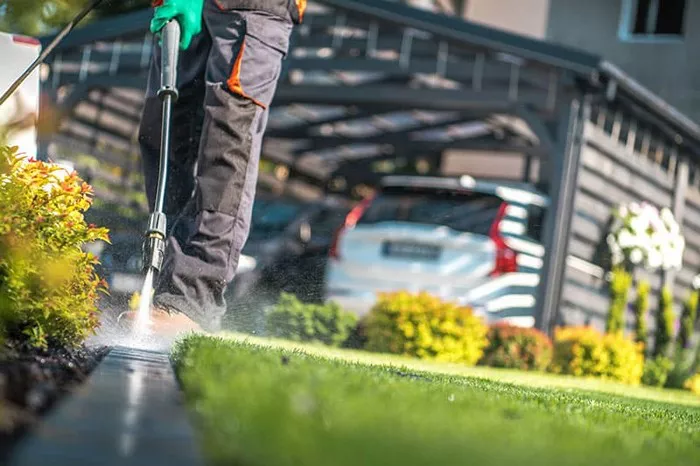Soft washing is an innovative cleaning method designed for exterior surfaces, utilizing low pressure combined with specialized cleaning solutions. Unlike traditional pressure washing, which can be abrasive and damaging, soft washing provides a gentler approach that effectively removes dirt, grime, and organic growth such as algae, mold, and mildew.
One of the primary advantages of soft washing is its ability to clean thoroughly without causing damage to delicate surfaces like shingles, wood, and painted surfaces. Traditional pressure washing can strip paint, damage siding, and leave surfaces vulnerable to future damage. In contrast, soft washing is designed to preserve the integrity of the surfaces while effectively removing contaminants.
See also: Pressure Washing Your Driveway
How Does a Soft Wash System Work?
The Core Components
A soft wash system comprises several key components, each playing a crucial role in the cleaning process:
Pressure Washer: Unlike in high-pressure systems, in a soft wash setup, the pressure washer’s role is primarily to provide a steady flow of water rather than high pressure. The water flow aids in the distribution of the cleaning solution across the surface.
Soft Wash Pump: This specialized pump controls and regulates the water pressure, ensuring it remains low to avoid damage to delicate surfaces. It works in tandem with the pressure washer to maintain a gentle yet effective cleaning process.
Solution Tank: This tank holds the cleaning mixture, which typically includes water, bleach, and a surfactant. The tank is designed to keep the solution well-mixed and ready for application.
Downstream Injector: This component is responsible for injecting the cleaning solution into the water stream. It ensures that the solution is properly mixed with the water before reaching the spray wand.
Spray Wand and Nozzles: The spray wand, equipped with specialized nozzles, delivers the cleaning solution at low pressure. Different nozzle types can be used to adjust the spray pattern and pressure, allowing for versatility in application.
The Cleaning Process
Pre-wetting the Surface: Before applying the cleaning solution, the surface is pre-wetted with water. This step helps prepare the surface, reducing the absorption of chemicals and minimizing runoff. It also helps to loosen dirt and grime, making the cleaning process more effective.
Mixing the Cleaning Solution: The cleaning solution is typically a mix of water, bleach, and a surfactant. The bleach helps to kill and remove organic growth, while the surfactant ensures the solution adheres to the surface and penetrates deeply into stains. The exact ratio of these components can vary based on the type of surface and the severity of the contamination.
Applying the Solution: Using the spray wand, the cleaning solution is applied to the surface with a soft spray pattern. This gentle application ensures even coverage without causing damage. The low pressure allows the solution to penetrate deeply into the surface, effectively breaking down dirt and organic matter.
Dwell Time: After application, the solution is left to dwell on the surface for a specified period. This dwell time is crucial as it allows the cleaning agents to break down contaminants and kill organic growth. The length of the dwell time can vary based on the surface material and the extent of the staining or growth.
Rinsing: Depending on the surface and the cleaning solution used, rinsing may be necessary. Rinsing helps to remove any residual cleaning solution and loosened dirt, leaving the surface clean and residue-free. In some cases, no rinsing is required, and the solution can be left to air dry.
Safety Considerations
When using a soft wash system, safety is paramount. Here are some essential safety considerations to keep in mind:
Personal Protective Equipment (PPE): Always wear appropriate PPE, including gloves, safety goggles, and protective clothing, when handling chemicals. PPE helps protect against chemical splashes and exposure to potentially harmful substances.
Proper Ventilation: When using bleach-based solutions, ensure proper ventilation to avoid inhaling fumes. Working in well-ventilated areas or using respiratory protection can help minimize the risk of respiratory issues.
Responsible Disposal: Dispose of leftover cleaning solutions responsibly. Follow local regulations for chemical disposal to avoid environmental contamination. Never pour unused chemicals down drains or into water sources.
See also: A Guide to Pressure Washing Vinyl Siding Safely and Effectively
Conclusion
Soft washing offers numerous benefits for exterior cleaning, providing a safe, effective, and gentle method for removing dirt and organic growth. By using low pressure and specialized cleaning solutions, soft washing preserves the integrity of surfaces while delivering superior cleaning results.
For homeowners and property managers looking to maintain their exteriors, professional soft washing services are available to handle complex jobs. These professionals have the expertise and equipment to ensure thorough and safe cleaning.
Additional Tips (Optional)
Nozzle Types: Different nozzle types can be used for various soft washing applications. For example, fan nozzles provide a wide spray pattern ideal for large surfaces, while pinpoint nozzles are suitable for targeting specific spots. Choosing the right nozzle can enhance the effectiveness and efficiency of the cleaning process.
Common Cleaning Solutions: In soft washing, the most common cleaning solutions include a mix of water, bleach, and surfactants. Bleach effectively kills and removes organic growth, while surfactants help the solution adhere to surfaces and break down dirt. Other additives may be used based on specific cleaning needs, such as algaecides or mildewcides for targeted treatments.

